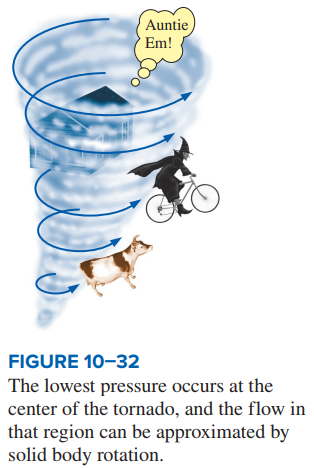SOLUTION We are to calculate the pressure field P(r) in a horizontal radial slice through a tornado for which the velocity components are approximated by Eq. 1. We are also to calculate the pressure in this horizontal slice at r = 0.
Assumptions 1 The flow is steady and incompressible. 2 Although R increases and 𝜔 decreases with increasing elevation z, R and 𝜔 are assumed to be constants when considering a particular horizontal slice. 3 The flow in the horizontal slice is two-dimensional in the r𝜃-plane (no dependence on z and no w-component of velocity). 4 The effects of gravity are negligible within a particular horizontal slice (an additional hydrostatic pressure field exists in the z-direction, of course, but this does not affect the dynamics of the flow, as discussed previously).
Analysis In the inner region, the Euler equation is an appropriate approximation of the Navier–Stokes equation, and the pressure field is found by integration. In Example 10–3 we showed that for solid body rotation,
Pressure field in inner region (r < R): P=\rho \frac{\omega^{2} r^{2}}{2}+P_{0} (2)
where P_{0} is the (unknown) pressure at r = 0 and we have neglected the gravity term. Since the outer region is a region of irrotational flow, the Bernoulli equation is appropriate and the Bernoulli constant is the same everywhere from r = R outward to r → ∞. The Bernoulli constant is found by applying the boundary condition far from the tornado, namely, as r \rightarrow \infty, u_{\theta} \rightarrow 0 \text { and } P \rightarrow P_{\infty} (Fig. 10–29). Equation 10–27 yields
Steady incompressible Bernoulli equation in irrotational regions of flow:
\frac{P}{\rho}+\frac{V^{2}}{2}+g z=C=\text { constant everywhere } (10-27)
As r → ∞: \underbrace{\frac{P}{\rho}}_{P_{\infty/}{\rho}}+\underbrace{\frac{V^{2}}{2}}_{V \rightarrow 0 \text { as } r \rightarrow \infty}+\underbrace{g z}_{assumption 4}=C \rightarrow C=\frac{P_{\infty}}{\rho} (5)
The pressure field anywhere in the outer region is obtained by substituting the value of constant C from Eq. 3 into the Bernoulli equation (Eq. 10–27). Neglecting gravity,
In outer region (r > R): P=\rho C-\frac{1}{2} \rho V^{2}=P_{\infty}-\frac{1}{2} \rho V^{2} (4)
We note that V^{2}=u_{\theta}^{2}. After substitution of Eq. 1 for u_{\theta}, Eq. 4 reduces to
Pressure field in outer region (r > R): P=P_{\infty}-\frac{\rho}{2} \frac{\omega^{2} R^{4}}{r^{2}} (5)
At r = R, the interface between the inner and outer regions, the pressure must be continuous (no sudden jumps in P ), as illustrated in Fig. 10–30. Equating Eqs. 2 and 5 at this interface yields
Pressure at r = R: P_{r=R}=\rho \frac{\omega^{2} R^{2}}{2}+P_{0}=P_{\infty}-\frac{\rho}{2} \frac{\omega^{2} R^{4}}{R^{2}} (6)
from which the pressure P_{0} at r = 0 is found,
Pressure at r = 0: P_{0}=P_{\infty}-\rho \omega^{2} R^{2} (7)
Equation 7 provides the value of pressure in the middle of the tornado—the eye of the storm. This is the lowest pressure in the flow field. Substitution of Eq. 7 into Eq. 2 enables us to rewrite Eq. 2 in terms of the given far-field ambient pressure P_{infty},
In inner region (r < R): P=P_{\infty}-\rho \omega^{2}\left(R^{2}-\frac{r^{2}}{2}\right) (8)
Instead of plotting P as a function of r in this horizontal slice, we plot a nondimensional pressure distribution instead, so that the plot is valid for any horizontal slice. In terms of nondimensional variables,
Inner region (r < R): \frac{u_{\theta}}{\omega R}=\frac{r}{R} \quad \frac{P-P_{\infty}}{\rho \omega^{2} R^{2}}=\frac{1}{2}\left(\frac{r}{R}\right)^{2}-1
Outer region (r > R): \frac{u_{\theta}}{\omega R}=\frac{R}{r} \quad \frac{P-P_{\infty}}{\rho \omega^{2} R^{2}}=-\frac{1}{2}\left(\frac{R}{r}\right)^{2} (9)
Figure 10–31 shows both nondimensional tangential velocity and nondimensional pressure as functions of nondimensional radial location.
Discussion In the outer region, pressure increases as speed decreases— a direct result of the Bernoulli equation, which applies with the same Bernoulli constant everywhere in the outer region. You are encouraged to calculate P in the outer region by an alternate method—direct integration of the Euler equation without use of the Bernoulli equation; you should get the same result. In the inner region, P increases parabolically with r even though speed also increases; this is because the Bernoulli constant changes from streamline to streamline (as also pointed out in Example 10–3). Notice that even though there is a discontinuity in the slope of tangential velocity at r /R = 1, the pressure has a fairly smooth transition between the inner and outer regions. The pressure is lowest in the center of the tornado and rises to atmospheric pressure in the far field (Fig. 10–32). The flow in the inner region is rotational but inviscid, since viscosity plays no role in that region of the flow. In fact, the inner region can even consist of a different fluid than the outer region. For example, a tank of water draining through a hole in the bottom of a tank often forms a “bathtub vortex” (Fig. 10–28b) that can be approximated as an inner region of air and an outer region of water. The flow in the outer region is irrotational but viscous. Note, however, that viscosity still acts on fluid particles in the outer region. (Viscosity causes the fluid particles to shear and distort, even though the net viscous force on any fluid particle in the outer region is zero.)




